英语写作中的标点符号用法
- 格式:docx
- 大小:28.96 KB
- 文档页数:11
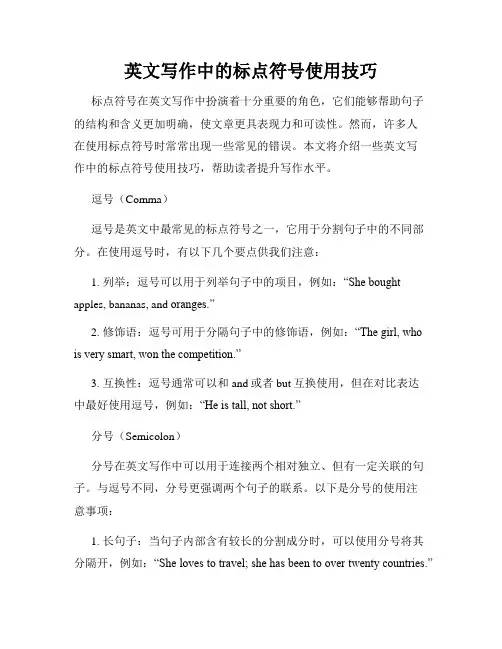
英文写作中的标点符号使用技巧标点符号在英文写作中扮演着十分重要的角色,它们能够帮助句子的结构和含义更加明确,使文章更具表现力和可读性。
然而,许多人在使用标点符号时常常出现一些常见的错误。
本文将介绍一些英文写作中的标点符号使用技巧,帮助读者提升写作水平。
逗号(Comma)逗号是英文中最常见的标点符号之一,它用于分割句子中的不同部分。
在使用逗号时,有以下几个要点供我们注意:1. 列举:逗号可以用于列举句子中的项目,例如:“She bought apples, bananas, and oranges.”2. 修饰语:逗号可用于分隔句子中的修饰语,例如:“The girl, who is very smart, won the competition.”3. 互换性:逗号通常可以和and或者but互换使用,但在对比表达中最好使用逗号,例如:“He is tall, not short.”分号(Semicolon)分号在英文写作中可以用于连接两个相对独立、但有一定关联的句子。
与逗号不同,分号更强调两个句子的联系。
以下是分号的使用注意事项:1. 长句子:当句子内部含有较长的分割成分时,可以使用分号将其分隔开,例如:“She loves to travel; she has been to over twenty countries.”2. 顺接关系:如果两个句子之间存在顺接关系,可以使用分号表示,例如:“He was tired; however, he continued working.”连字符(Hyphen)连字符在英文写作中有多种用途,我们可以通过以下几个方面了解其使用技巧:1. 连接单词:连字符可以用于连接两个或多个有关联的单词,例如:“state-of-the-ar t technology”。
2. 描述范围:在表示范围时,可以使用连字符,例如:“pages 35-39”。
3. 合成词:在形成合成词时,连字符可以连接两个单词,例如:“well-known”, “life-changing”。
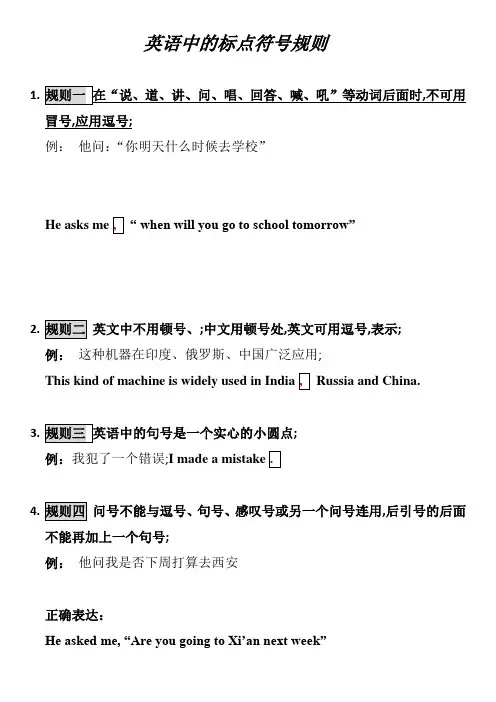
英语中的标点符号规则1.冒号,应用逗号;例:他问:“你明天什么时候去学校”“ when will you go to school tomorrow”2.英文中不用顿号、;中文用顿号处,英文可用逗号,表示;例:这种机器在印度、俄罗斯、中国广泛应用;Russia and China.3.;例:我犯了一个错误;4.问号不能与逗号、句号、感叹号或另一个问号连用,后引号的后面不能再加上一个句号;例:他问我是否下周打算去西安正确表达:He asked me, “Are you going to Xi’an next week”错误表达:5.,冒号和分号必须置于引号之外;问号和感叹号,如果与引语有关,放在引号之内;如与整个句子有关,则放在引号之外;She said, “I want to see a movie.”“The movie,” she said, “ is interesting.”I am reading “A Tale of Two Cities”. 我正在看双城记;英文中省略号是三个点,居下;中文中省略号是六个点,居中;例:他想啊,想啊,想啊……He thought, and thought, and thought…6.,或放在一个主句和从句之间,也不能引起多个并列的结构;另外,分号后面的分句前面不能再使用并列连词and, but, or, for等;附:分号的用法1)用于没有连接词连接而句子的关系又比较密切的并列句之间;太阳现在开始落下;影子变得很长;The sun was setting now; the shadows were long.2)用以代替逗号,分隔句中已含有逗号的部分;There are two facts to consider: first, the weather; second, the expense.两件事需要考虑:第一件,天气;第二件,花销;。
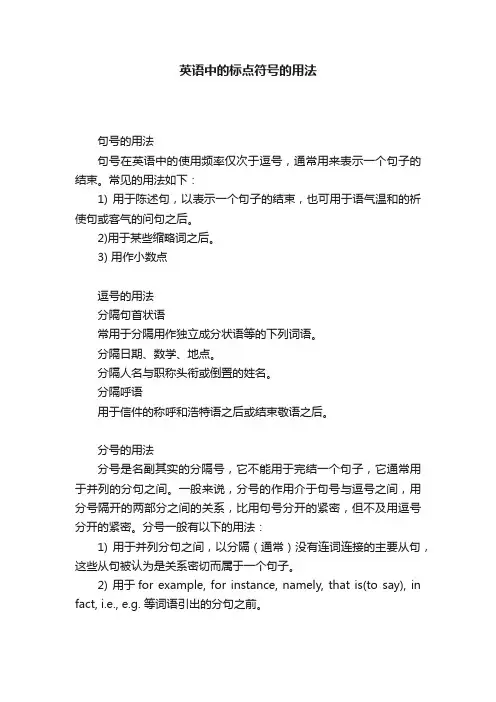
英语中的标点符号的用法句号的用法句号在英语中的使用频率仅次于逗号,通常用来表示一个句子的结束。
常见的用法如下:1) 用于陈述句,以表示一个句子的结束,也可用于语气温和的祈使句或客气的问句之后。
2)用于某些缩略词之后。
3) 用作小数点逗号的用法分隔句首状语常用于分隔用作独立成分状语等的下列词语。
分隔日期、数学、地点。
分隔人名与职称头衔或倒置的姓名。
分隔呼语用于信件的称呼和浩特语之后或结束敬语之后。
分号的用法分号是名副其实的分隔号,它不能用于完结一个句子,它通常用于并列的分句之间。
一般来说,分号的作用介于句号与逗号之间,用分号隔开的两部分之间的关系,比用句号分开的紧密,但不及用逗号分开的紧密。
分号一般有以下的用法:1) 用于并列分句之间,以分隔(通常)没有连词连接的主要从句,这些从句被认为是关系密切而属于一个句子。
2) 用于for example, for instance, namely, that is(to say), in fact, i.e., e.g. 等词语引出的分句之前。
冒号的用法冒号是一个补充、连贯的符号,被用来引起读者注意下文。
冒号多用于正式而庄重的问题中,具体用法如下:1) 列出表示列举、解释、或说明性的词语。
2) 引出较长的正式引语或大段引语。
3) 用于信件或演说词中的称呼语之后(英国用法中多用逗号)。
4) 用于时与分之间(英国用法中多用句号)、比率数之间、《圣经》的章与节之间。
5) 分隔书名的标题与副标题。
问号的用法问号,就是用在问句之后的符号,多用于对话中,书面表达中相对较少。
问号的一般用法如下:1) 用于疑问句或语气婉转的祈使句之后。
2) 用在括孤内表示存疑或无把握。
叹号的用法感叹号,用于抒发强烈的情感,如惊叹,赞赏,呼吁,决心,或用来表示强调,命令等。
通常感叹号有以下用法:1) 用于加强命令语气或引起注意。
2) 表示感叹、赞美、嘲讽或玩笑。
连字符的用法在英语中,连字符的作用是多方面的,其用法灵活多变。
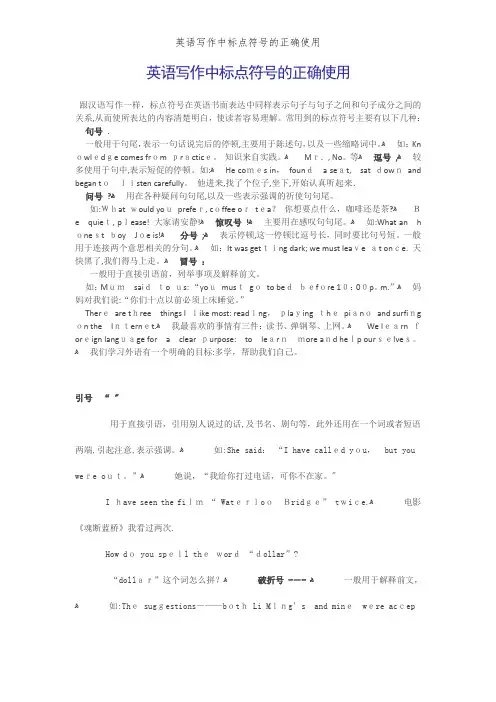
英语写作中标点符号的正确使用跟汉语写作一样,标点符号在英语书面表达中同样表示句子与句子之间和句子成分之间的关系,从而使所表达的内容清楚明白,使读者容易理解。
常用到的标点符号主要有以下几种:句号.一般用于句尾,表示一句话说完后的停顿,主要用于陈述句,以及一些缩略词中。
ﻫ如: Kn owledge comes from practice。
知识来自实践。
ﻫMr., No。
等ﻫ逗号,ﻫ较多使用于句中,表示短促的停顿。
如:ﻫHe comes in,found a seat,sat downand began tolisten carefully。
他进来,找了个位子,坐下,开始认真听起来.问号?ﻫ用在各种疑问句句尾,以及一些表示强调的祈使句句尾。
如:What would youprefer, coffee ortea?你想要点什么,咖啡还是茶?ﻫBe quiet, please! 大家请安静!ﻫ惊叹号!ﻫ主要用在感叹句句尾。
ﻫ如:What an h onest boy Joe is!ﻫ分号;ﻫ表示停顿,这一停顿比逗号长,同时要比句号短。
一般用于连接两个意思相关的分句。
ﻫ如: It was getting dark; we must leave at once. 天快黑了,我们得马上走。
ﻫ冒号:一般用于直接引语前,列举事项及解释前文。
如:Mumsaidto us: “youmustgoto bedbefore 10:00p。
m.”ﻫ妈妈对我们说:“你们十点以前必须上床睡觉。
”Thereare three things I like most: reading,playing thepianoand surfing on the Internet.ﻫ我最喜欢的事情有三件:读书、弹钢琴、上网。
ﻫWe learn foreign language for a clear purpose:to learnmore and help ourselves。
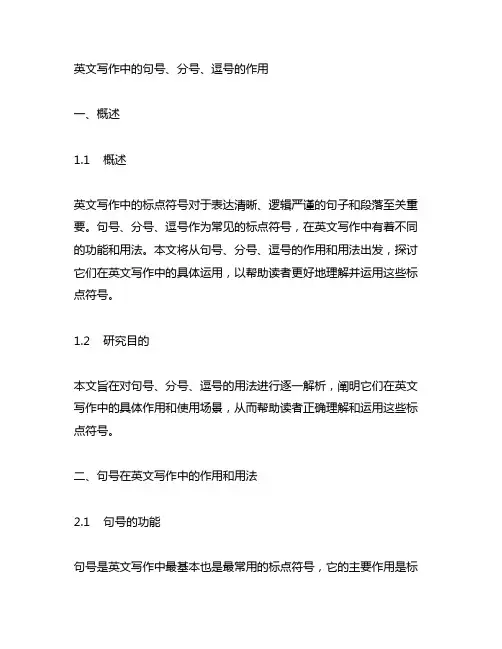
英文写作中的句号、分号、逗号的作用一、概述1.1 概述英文写作中的标点符号对于表达清晰、逻辑严谨的句子和段落至关重要。
句号、分号、逗号作为常见的标点符号,在英文写作中有着不同的功能和用法。
本文将从句号、分号、逗号的作用和用法出发,探讨它们在英文写作中的具体运用,以帮助读者更好地理解并运用这些标点符号。
1.2 研究目的本文旨在对句号、分号、逗号的用法进行逐一解析,阐明它们在英文写作中的具体作用和使用场景,从而帮助读者正确理解和运用这些标点符号。
二、句号在英文写作中的作用和用法2.1 句号的功能句号是英文写作中最基本也是最常用的标点符号,它的主要作用是标志句子的结束。
在句子末尾使用句号可以使句子结束得更加明确和稳定。
2.2 句号的使用场景句号通常用于陈述句、祈使句和句子末尾的缩略句。
例如:- 陈述句:He is a doctor.- 祈使句:Please be quiet.- 缩略句:I'll be there at 5 p.m.三、分号在英文写作中的作用和用法3.1 分号的功能分号在英文写作中主要用于连接两个具有独立意义的句子,使它们之间的关系更加紧密。
分号还可以用于列举、分隔长句和在引用文本中表示缺失部分。
3.2 分号的使用场景分号通常用于以下情况:- 连接具有独立意义的句子:I love to travel; it broadens my horizons.- 列举:She bought apples, oranges, and bananas; milk, bread, and eggs; and some snacks.- 分隔长句:The weather was gloomy; it had been r本人ning for hours.- 引用文本中表示缺失部分:She s本人d, "I like your dress; it's very beautiful."四、逗号在英文写作中的作用和用法4.1 逗号的功能逗号在英文写作中通常用于分隔并列成分,引导性从句和非限定性从句。
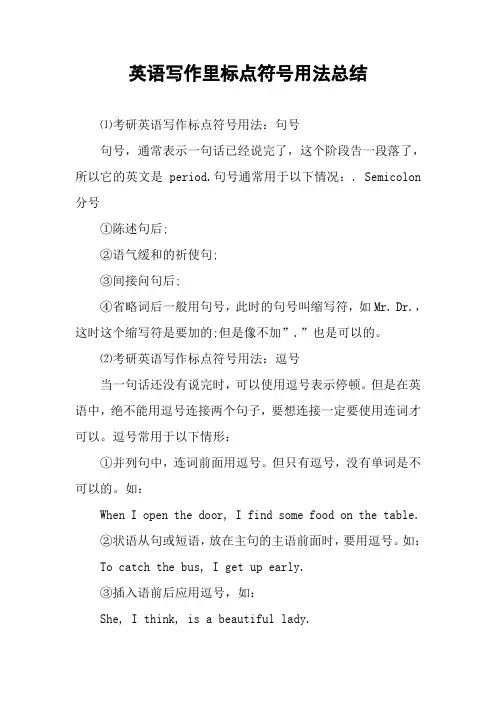
英语写作里标点符号用法总结⑴考研英语写作标点符号用法:句号句号,通常表示一句话已经说完了,这个阶段告一段落了,所以它的英文是period.句号通常用于以下情况:. Semicolon 分号①陈述句后;②语气缓和的祈使句;③间接问句后;④省略词后一般用句号,此时的句号叫缩写符,如Mr. Dr.,这时这个缩写符是要加的;但是像不加”.”也是可以的。
⑵考研英语写作标点符号用法:逗号当一句话还没有说完时,可以使用逗号表示停顿。
但是在英语中,绝不能用逗号连接两个句子,要想连接一定要使用连词才可以。
逗号常用于以下情形:①并列句中,连词前面用逗号。
但只有逗号,没有单词是不可以的。
如:When I open the door, I find some food on the table.②状语从句或短语,放在主句的主语前面时,要用逗号。
如:To catch the bus, I get up early.③插入语前后应用逗号,如:She, I think, is a beautiful lady.④日期当中使用逗号,英文的日期表达顺序和中文不一样,中文通常是从大到小,而英文通常是从小到大。
如:月,日,年May 1,20XX;日,月,年 1 May, 20XX-7-6⑤非限制性定语从句中,也需要用逗号将主句和从句分隔开。
如:As is known, the moon goes around the earth.⑶考研英语写作标点符号用法:顿号英文中无顿号,想要表示停顿,只能使用逗号,这是中文和英文差距非常大的地方。
⑷考研英语写作标点符号用法:问号问号是表示提问的。
通常在疑问句后用问号,若疑问句被改为间接引语的话,就不用问号。
⑸考研英语写作标点符号用法:感叹号感叹号在考研英语写作中要少用。
因为通常感叹句、祈使句后感叹号比较多。
而考研英语作文多为议论文,态度较客观,所以应该少用感叹句。
⑹考研英语写作标点符号用法:引号引号,主要出现在引语中。
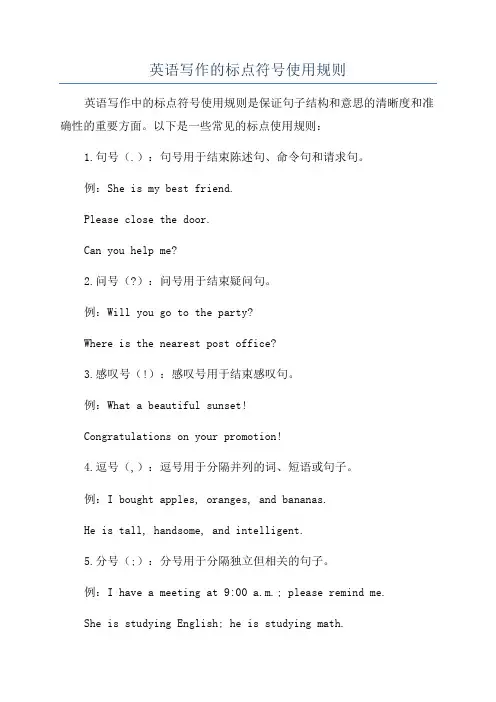
英语写作的标点符号使用规则英语写作中的标点符号使用规则是保证句子结构和意思的清晰度和准确性的重要方面。
以下是一些常见的标点使用规则:1.句号(.):句号用于结束陈述句、命令句和请求句。
例:She is my best friend.Please close the door.Can you help me?2.问号(?):问号用于结束疑问句。
例:Will you go to the party?Where is the nearest post office?3.感叹号(!):感叹号用于结束感叹句。
例:What a beautiful sunset!Congratulations on your promotion!4.逗号(,):逗号用于分隔并列的词、短语或句子。
例:I bought apples, oranges, and bananas.He is tall, handsome, and intelligent.5.分号(;):分号用于分隔独立但相关的句子。
例:I have a meeting at 9:00 a.m.; please remind me.She is studying English; he is studying math.6.冒号(:):冒号用于介绍、引出或解释一个事物或观点。
例:There are four seasons: spring, summer, autumn, and winter.Your essay should include three main points: introduction, body, and conclusion.7.引号(""或''):引号用于引用直接的或间接的语句。
例:He said, "I love you."The famous saying goes, "Actions speak louder than words."8.括号(():括号用于插入附加信息或解释。
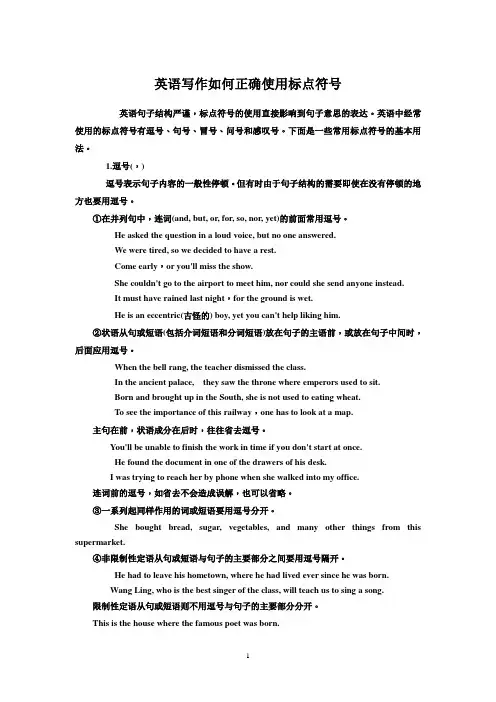
英语写作如何正确使用标点符号英语句子结构严谨,标点符号的使用直接影响到句子意思的表达。
英语中经常使用的标点符号有逗号、句号、冒号、问号和感叹号。
下面是一些常用标点符号的基本用法。
1.逗号(,)逗号表示句子内容的一般性停顿。
但有时由于句子结构的需要即使在没有停顿的地方也要用逗号。
①在并列句中,连词(and, but, or, for, so, nor, yet)的前面常用逗号。
He asked the question in a loud voice, but no one answered.We were tired, so we decided to have a rest.Come early,or you'll miss the show.She couldn't go to the airport to meet him, nor could she send anyone instead.It must have rained last night,for the ground is wet.He is an eccentric(古怪的) boy, yet you can't help liking him.②状语从句或短语(包括介词短语和分词短语)放在句子的主语前,或放在句子中间时,后面应用逗号。
When the bell rang, the teacher dismissed the class.In the ancient palace, they saw the throne where emperors used to sit.Born and brought up in the South, she is not used to eating wheat.To see the importance of this railway,one has to look at a map.主句在前,状语成分在后时,往往省去逗号。
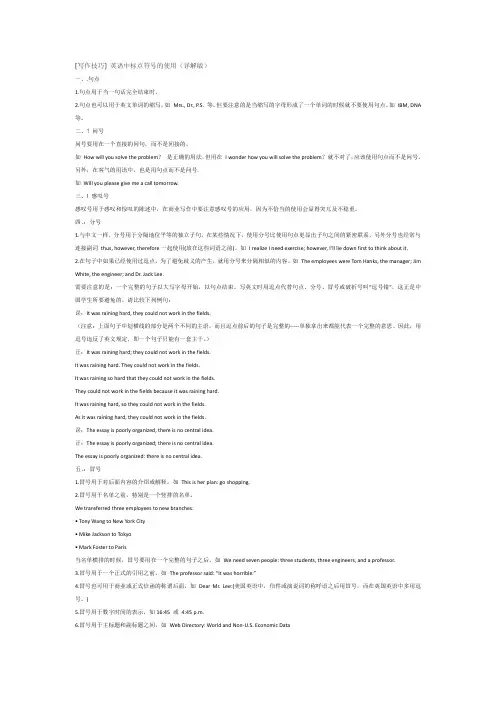
[写作技巧]英语中标点符号的使用(详解版)一、.句点1.句点用于当一句话完全结束时。
2.句点也可以用于英文单词的缩写,如Mrs., Dr., P.S. 等。
但要注意的是当缩写的字母形成了一个单词的时候就不要使用句点。
如IBM, DNA 等。
二、?问号问号要用在一个直接的问句,而不是间接的。
如How will you solve the problem?是正确的用法,但用在I wonder how you will solve the problem?就不对了,应该使用句点而不是问号。
另外,在客气的用语中,也是用句点而不是问号.如Will you please give me a call tomorrow.三、! 感叹号感叹号用于感叹和惊叹的陈述中,在商业写作中要注意感叹号的应用,因为不恰当的使用会显得突兀及不稳重。
四、;分号1.与中文一样,分号用于分隔地位平等的独立子句。
在某些情况下,使用分号比使用句点更显出子句之间的紧密联系,另外分号也经常与连接副词thus, however, therefore一起使用(放在这些词语之前)。
如I realize I need exerci se; however, I’ll lie down first to think about it.2.在句子中如果已经使用过逗点,为了避免歧义的产生,就用分号来分隔相似的内容。
如The employees were Tom Hanks, the manager; Jim White, the engineer; and Dr. Jack Lee.需要注意的是:一个完整的句子以大写字母开始,以句点结束。
写英文时用逗点代替句点、分号、冒号或破折号叫“逗号错”,这正是中国学生所要避免的。
请比较下列例句:误:It was raining hard, they could not work in the fields.(注意:上面句子中划横线的部分是两个不同的主语,而且逗点前后的句子是完整的-----单独拿出来都能代表一个完整的意思。
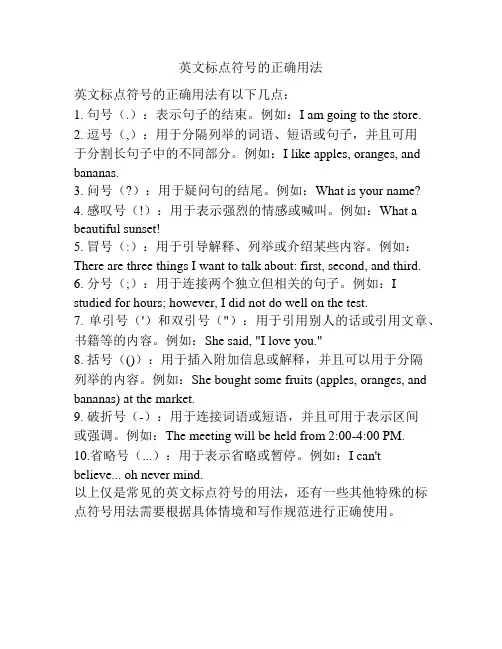
英文标点符号的正确用法英文标点符号的正确用法有以下几点:1. 句号(.):表示句子的结束。
例如:I am going to the store.2. 逗号(,):用于分隔列举的词语、短语或句子,并且可用于分割长句子中的不同部分。
例如:I like apples, oranges, and bananas.3. 问号(?):用于疑问句的结尾。
例如:What is your name?4. 感叹号(!):用于表示强烈的情感或喊叫。
例如:What a beautiful sunset!5. 冒号(:):用于引导解释、列举或介绍某些内容。
例如:There are three things I want to talk about: first, second, and third.6. 分号(;):用于连接两个独立但相关的句子。
例如:I studied for hours; however, I did not do well on the test.7. 单引号(')和双引号("):用于引用别人的话或引用文章、书籍等的内容。
例如:She said, "I love you."8. 括号(()):用于插入附加信息或解释,并且可以用于分隔列举的内容。
例如:She bought some fruits (apples, oranges, and bananas) at the market.9. 破折号(-):用于连接词语或短语,并且可用于表示区间或强调。
例如:The meeting will be held from 2:00-4:00 PM. 10.省略号(...):用于表示省略或暂停。
例如:I can't believe... oh never mind.以上仅是常见的英文标点符号的用法,还有一些其他特殊的标点符号用法需要根据具体情境和写作规范进行正确使用。
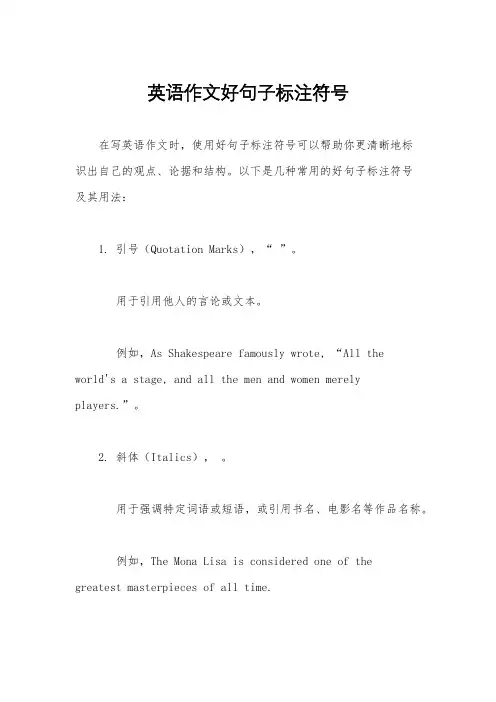
英语作文好句子标注符号在写英语作文时,使用好句子标注符号可以帮助你更清晰地标识出自己的观点、论据和结构。
以下是几种常用的好句子标注符号及其用法:1. 引号(Quotation Marks),“ ”。
用于引用他人的言论或文本。
例如,As Shakespeare famously wrote, “All theworld's a stage, and all the men and women merely players.”。
2. 斜体(Italics),。
用于强调特定词语或短语,或引用书名、电影名等作品名称。
例如,The Mona Lisa is considered one of thegreatest masterpieces of all time.3. 方括号(Square Brackets),[ ]用于插入作者自己的解释、补充或更正。
例如,The population of China [excluding Hong Kong and Macau] exceeds 1.4 billion.4. 括号(Parentheses),( )。
用于插入额外的信息、解释或缩写词的全称。
例如,The capital of France is Paris (pronounced puh-REE).5. 破折号(Dash),—。
用于插入一个补充说明、解释或强调。
例如,The weather—typically unpredictable in April—can affect outdoor events.6. 分号(Semicolon),;用于连接两个独立但相关的句子。
例如,She enjoys painting; it relaxes her after a long day at work.7. 冒号(Colon),:用于引出一个列表、解释或引述。
例如,There are three things every writer needs to succeed: dedication, creativity, and perseverance.8. 逗号(Comma),,。
英语写作中标点符号的正确使用跟汉语写作一样,标点符号在英语书面表达中同样表示句子与句子之间和句子成分之间的关系,从而使所表达的内容清楚明白,使读者容易理解。
常用到的标点符号主要有以下几种:句号.一般用于句尾,表示一句话说完后的停顿,主要用于陈述句,以及一些缩略词中。
如: Knowledge comes from practice. 知识来自实践。
Mr., No.等逗号,较多使用于句中,表示短促的停顿。
如:He comes in, found a seat, sat down and began to listen carefully. 他进来,找了个位子,坐下,开始认真听起来。
问号?用在各种疑问句句尾,以及一些表示强调的祈使句句尾。
如:What would you prefer, coffee or tea? 你想要点什么,咖啡还是茶?Be quiet, please! 大家请安静!惊叹号!主要用在感叹句句尾。
如:What an honest boy Joe is!分号;表示停顿,这一停顿比逗号长,同时要比句号短。
一般用于连接两个意思相关的分句。
如: It was getting dark; we must leave at once. 天快黑了,我们得马上走。
冒号:一般用于直接引语前,列举事项及解释前文。
如:Mum said to us: “you must go to bed before 10:00p.m.”妈妈对我们说:“你们十点以前必须上床睡觉。
”There are three things I like most: reading, playing the piano and surfing on the Internet.我最喜欢的事情有三件:读书、弹钢琴、上网。
We learn foreign language for a clear purpose: to learn more and help ourselves.我们学习外语有一个明确的目标:多学,帮助我们自己。
以下是一些英语常用的标点符号及其表达方式:
1. 句号 (.):表达一个完整的想法或句子结束。
2. 逗号(,):用于分隔单词或短语,或者在句子中插入一个较短的停顿。
3. 冒号(:):用于列举项目或解释说明,例如在信件或引言中。
4. 分号(;):用于分隔两个并列的句子或子句,或者在列举项目时分隔不同的项。
5. 问号 (?):用于表达一个问题。
6. 感叹号 (!):用于表达强烈的感情或惊叹。
7. 引号 (''):用于引用他人的话或表示强调。
8. 单引号('):用于引用较短的词或词组,或者表示某些特殊的字符。
9. 双引号(""):用于引用较长的句子或段落,或者表示一些特殊的表达方式。
10. 破折号 (-):用于表示意思的转折或突出某些内容。
11. 斜杠 (/):用于表示选择、替代或注释。
12. 空格():在英语中,空格是一种重要的标点符号,用于分隔单词和句子。
这些标点符号在英语写作中非常重要,可以帮助读者更好
地理解文章的含义和结构。
英语写作中英文标点符号的使用句点(Full Stop / Period,“。
”)问号(Question Mark,“?”)感叹号(Exclamation Mark,“!")逗点(Comma,“,")冒号(Colon,“:")分号(Semicolon,“;")连字符(Hyphen,“—”)连接号(En Dash,“–")破折号(Em Dash,“—”)括号(Parentheses,小括号“( )”;中括号“[]”;大括号“{}")引号(Quotation Marks,双引号“"”;单引号“‘”)缩写及所有格符号(Apostrophe,“‘”)一、.句点1.句点用于当一句话完全结束时.2。
句点也可以用于英文单词的缩写,如 Mrs。
, Dr., P。
S. 等。
但要注意的是当缩写的字母形成了一个单词的时候就不要使用句点。
如 IBM, DNA 等。
二、?问号问号要用在一个直接的问句,而不是间接的。
如 How will you solve the problem?是正确的用法,但用在 I wonder how you will solve the problem?就不对了,应该使用句点而不是问号。
另外,在客气的用语中,也是用句点而不是问号.如 Will you please give me a call tomorrow.三、! 感叹号感叹号用于感叹和惊叹的陈述中,在商业写作中要注意感叹号的应用,因为不恰当的使用会显得突兀及不稳重。
四、;分号1。
与中文一样,分号用于分隔地位平等的独立子句.在某些情况下,使用分号比使用句点更显出子句之间的紧密联系,另外分号也经常与连接副词 thus, however, therefore一起使用(放在这些词语之前)。
如 I realize I need exercise; however, I’ll lie down first to think about it.2。
英文作文标点空格在英文作文中,正确的标点使用和空格放置是非常重要的。
以下是一些关于标点和空格使用的基本规则:1. 句号(.),句号用于句子的结束。
在句号后面,应该跟着一个空格,然后是下一句的第一个字母。
例如,I love writing. It's my passion.2. 逗号(,),逗号用于分隔句子中的项目、列举或者分隔句子的部分。
逗号后应该跟着一个空格,除非逗号后是句号。
例如,I like reading, writing, and painting.3. 分号(;),分号用于连接两个独立但相关的句子。
分号后面应该跟着一个空格。
例如,She studied hard for the exam; however, she didn't pass.4. 冒号(:),冒号用于引出列表、解释或者引用。
在冒号后面应该跟着一个空格。
例如,There are three things I love: reading, writing, and traveling.5. 感叹号(!),感叹号用于表示强烈的感情或者惊讶。
感叹号后面应该跟着一个空格,除非感叹号后是标点符号。
例如,Whata beautiful day it is!6. 问号(?),问号用于表示疑问。
问号后面应该跟着一个空格。
例如,Where are you going?7. 引号(""),引号用于引用别人的话或者表示直接引用的内容。
在引号内外都不需要空格。
例如,"I'll be there soon," he said.8. 括号(()),括号用于插入补充说明或者注释。
括号外应该跟着一个空格。
例如,He went to the store (which was closed) to buy some groceries.9. 破折号(-),破折号用于表示断断续续的思想、插入语或者连接词语。
[写作技巧]英语中标点符号的使用(详解版)一、.句点1.句点用于当一句话完全结束时。
2.句点也可以用于英文单词的缩写,如Mrs., Dr., P.S. 等。
但要注意的是当缩写的字母形成了一个单词的时候就不要使用句点。
如IBM, DNA 等。
二、?问号问号要用在一个直接的问句,而不是间接的。
如How will you solve the problem?是正确的用法,但用在I wonder how you will solve the problem?就不对了,应该使用句点而不是问号。
另外,在客气的用语中,也是用句点而不是问号.如Will you please give me a call tomorrow.三、! 感叹号感叹号用于感叹和惊叹的陈述中,在商业写作中要注意感叹号的应用,因为不恰当的使用会显得突兀及不稳重。
四、;分号1.与中文一样,分号用于分隔地位平等的独立子句。
在某些情况下,使用分号比使用句点更显出子句之间的紧密联系,另外分号也经常与连接副词thus, however, therefore一起使用(放在这些词语之前)。
如I realize I need exerci se; however, I’ll lie down first to think about it.2.在句子中如果已经使用过逗点,为了避免歧义的产生,就用分号来分隔相似的内容。
如The employees were Tom Hanks, the manager; Jim White, the engineer; and Dr. Jack Lee.需要注意的是:一个完整的句子以大写字母开始,以句点结束。
写英文时用逗点代替句点、分号、冒号或破折号叫“逗号错”,这正是中国学生所要避免的。
请比较下列例句:误:It was raining hard, they could not work in the fields.(注意:上面句子中划横线的部分是两个不同的主语,而且逗点前后的句子是完整的-----单独拿出来都能代表一个完整的意思。
英语标点符号正确用法
在英语中,标点符号是非常重要的,它们可以帮助读者理解句子和段落的意思。
以下是一些常见的英语标点符号的正确用法:
1.句号(.):用于表示一个完整的陈述或句子结束的地方。
2.逗号(,):用于分隔句子中的独立子句或短语,以及在列举或解释
时使用。
3.引号(“ ”):用于引用他人的话语或特定术语,也可以表示强调。
4.冒号(:):用于引出下文或解释说明,如列举、定义或描述。
5.分号(;):用于分隔两个独立的句子或子句,但它们之间存在某种
关系。
6.问号(?):用于疑问句的末尾,表示提出问题。
7.感叹号(!):用于感叹句或表达强烈的情感、惊讶或强调的句子末
尾。
8.破折号(–):用于表示意思的转折、注释或补充说明。
9.连字符(–):用于连接两个或多个单词,形成一个复合词或短语。
10.括号(()):用于插入补充信息或解释说明。
11.省略号(…):用于表示省略某些内容或意犹未尽的感觉。
在使用这些标点符号时,需要注意它们的正确位置和用法,以确保句子和段落的意义清晰明确。
英语写作中的标点符号用法(一)逗号的用法1. 在并列连词(and, but, for, nor, or, yet )前使用,用来连接句中的各分句。
In fact you do, but you may not remember me. (p17 全日制普通高级中学教科书(必修)英语第一册(下)Senior English for China Student’s Book 1B 以下标有页码未特别注明出处的皆出自本书)2. 用逗号来分隔一系列单词、词组和从句。
In summer, people like to go sailing, swimming, horse-riding and rock-climbing in the mountains. (p42)Red, pink, yellow and white roses filled the huge vases. (牛津现代高级英汉双解词典第6版附录4 标点使用法)In the summer of 1984, many trees died.3. 逗号用来分隔与句子其他部分密切相连的简短插入语或旁白。
(较长的,更为突兀的或复杂的插入成分的则用破折号或圆括号。
)Chemical fertilization,for example, helps to produce better crops, but is harmful to the environment. (p45-46)4. 在并列形容词,即分别修饰同一个名词的形容词之间使用逗号,但也有的形容词之间不加逗号的。
For men, heroism was usually described as bravery and the active, successful overcoming of adversity.5. 用逗号来分隔非限定性修饰语,即该修饰语对于句子的意义并非必不可少。
非限定性修饰语与限定性修饰语的区别在于,它即使被省略,也不会改变句子的主要意思。
(1) 同位语Ma De, former Party secretary of Suihua, in Northeast China’s Heilongjiang Province, was charged with taking bribes worth 6.03 million yuan during his 10 years in various government positions. (China Daily July29, 2005) At the World Park, one of the largest theme parks in China, visitors can look at buildings, castles and statues from more than thirty countries. (P66)注意:限定性同位语不用逗号隔开。
US President George W. Bush said on Wednesday that he looked forward to meeting President Hu Jintao later this year. (China Daily July29, 2005)(2) 从句A brief comparison with the most famous chivalric drama, which was written fifteen years earlier, clarifies the uniqueness of Thon’s play.与那部最着名的,完成于十五年前的骑士剧的简短比较,表明了索恩这部剧作的独特性。
When they discovered it about 1,000 years ago, they called it Aotearoa, which means “Land of the long white cloud”. (P38)(3) 副词短语和从句Just like spoken language, body language varies from culture to culture. (P59)He was born in Yidu, Shandong Province. (P48)By the way, did you hear about Sue’s car?Oh, so that’s where it was.6. 逗号可以用在一个很长的引导性短语或从句后,逗号还可以用来分隔表示选择或对比关系的短语。
You can feel what it is like to live in space, walk on the ocean floor or ski with polar bears at the North Pole. (P69)And remember, it is better to eat a potato than to be one. (P75)7. 在以“月、日、年”为次序排列的日期间使用逗号。
如果这种次序的日期出现在句子中间,则在“年”后也加上逗号。
Martin Luther King, Jr., was born on January 15, 1929, and died on April 4, 1968.但在以“日、月、年”为次序排列的日期间,不使用逗号。
Martin Luther King, Jr., was born on 15 January 1929, and died on 4 April 1968.在“月”和“年”之间,或“季节”和“年”之间,不使用逗号。
The events of July 1789 are as familiar to the French as those of July 1776 are to Americans.发生在1789年7月的那些事件对于法国人来说,就像美国人对于发生在1776年7月的那些时间一样熟悉。
8. 在表示地名时Pandas come from China, Asia.9. 用以将一导言的或转变语气的词或短语(如therefore, however, by the way, for instance)与句中其余部分隔开。
Yes, it certainly had an eventful day.In fact, I don’t even know her name.10. 书写对话时用于某某说等词语前后。
“Come back soon,” she said.11. 用于短小的引语前。
Disraeli said, “Little things affect little minds.”(二)对话及引语标点符号用法1. 对话(1) 说话人在前,说话内容在后。
一般而言,say后用逗号,引号内第一个单词第一个字母大写,引文内句子意思完整,则标点符号(句号、叹号、问号、省略号、破折号等)放在引号内。
My friend said, “You’re getting compulsive about this stuff.”(2) 说话人在后,说话内容全部前置。
一般而言,如果是陈述句,引号内用逗号,引号外第一个单词第一个字母小写;如果是疑问句或感叹句,引号内用问号或感叹号,引号外第一单词第一个字母小写。
“It’s a deal,” he said, laughing.“No,” he said.“You coming back?” the policeman asked.(3) 说话人在中间,说话内容分列于说话人前后。
一般而言,说话人(he)引号内用逗号,引号外第一个单词的第一个字母小写;如果he said(有时也用said he或其他形式)后用句号,则后边引号第一个单词第一个字母用大写;如果he said后用逗号,则后边引号第一个单词的第一个字母也小写。
“I bet,” he said. “Can I try it?”“You can go any place you want,” Beto said, “but I think you’ll find whatyou need.”(p73 Field Work, Bruce Jackson, University of Illinois Press)“They agreed to continue consultations,” said Qin Gang, spokesman for the Chinese delegation. “The meetings alone are progress.”(China Daily July29, 2005)2. 引语(1) 英语中,如果所引用的句子不是特别长,且不需特别强调,可以直接用引号表示引语部分。
“It was the best of times, it was the worst of times,”wrote Charles Dickens about the eighteenth century.查尔斯·狄更斯对于十八世纪这样写道,“这是最好的时代,同时也是最糟的时代。
”Their raincoats have been left behind, for the radio reports “Fair tonight and tomorrow with gentle westerly winds.”(2) 也有只引用一个词或词组的。
And while “a picture may be worth a thousand words,” this is true only if the picture is taken in a particular way and is then properly analyzed.Yet for multitudes, the photographic record is true because “the camera cannot lie.”For Charles Dickens, the eighteenth century was both “the best of times”and “the worst of times.”句中的“the worst of times.”引号内的句号常放在引号外。
(审读室建议咱们报社统一采用此种形式。
)When they discovered it about 1,000 years ago, they called it Aotearoa, which means “Land of the long white cloud”. (P38)(3) 引语可以放在句首、句中或句末。